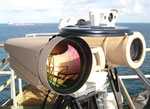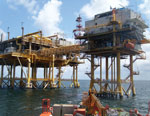
Keeping Infrastructure Resilient
Broad measures in place to protect transportation of reliable energy
- By Ralph C. Jensen
- Feb 01, 2010
 Natural gas accounts for about 25 percent of energy consumed in the United States. The nation's vast network of gas and oil pipelines are a critical part of the nation's infrastructure and are subject to homeland security protections and federal mandates.
Natural gas accounts for about 25 percent of energy consumed in the United States. The nation's vast network of gas and oil pipelines are a critical part of the nation's infrastructure and are subject to homeland security protections and federal mandates.
The threat against a network of gas pipelines goes far beyond the possibility of terrorism, and includes natural causes and careless excavation. Security, as well as the inherent design and operation of a natural gas pipeline system, can help reduce the probability of an incident, which could have an adverse affect on the nation.
Well-organized security plans depend on the inherent characteristics of the natural gas pipeline system, especially in the vicinity of a pipeline that would impact not only energy delivery but also residents near a network.
Safeguarding Facilities
Because the pipeline network is subject to federal mandates and Department of Homeland Security objectives, the natural gas pipeline industry has been diligent in taking steps to safeguard critical facilities against possible terrorism and ensure the ability to recover from an incident.
"Using the right security equipment along the pipeline route is absolutely essential," said Scott V. Burkhardt, a marketing programs specialist at Canon U.S.A. Inc. "IP video surveillance with analytics at the edge can not only provide security on the spot, but camera operators and the pipeline end user can take a video tour of the pipeline to ensure that all is well along the transmission line."
The security of a pipeline is two-fold.
Pipeline companies are concerned for the well-being of those who might be affected by an incident or a disruption. If an event occurs at a compressor station, this also will likely affect people who live or work near the pipeline.
One concern is escaping gas, which is highly fl ammable, but the other worry involves pipelines as a potential terrorist target. There is a low probability of fatalities and injures at the point of disruption because the majority of interstate pipeline infrastructure is buried underground and located in remote, sparsely populated areas. Nevertheless, first responders and gas company workers must respond and have the proper training to control such an event.
A broader concern is the consequence of interupted natural gas service to potentially thousands of homes and businesses, as well as industries and electric generators that own natural gas interstate pipelines.
Security will play an ever increasing role within the transportation industry, particularly in the pipeline business, as the Interstate Natural Gas Association of America projects an infrastructure investment of up to $210 billion through 2030.
The Security Industry's Role
"Security plays an integral role in the petrochemical industry as well as a key role in pipeline security," said Bill Klink, vice president of security and surveillance at FLIR Systems Inc. "From our perspective, thermal imaging allows security officers to see in the dark and in challenging environmental circumstances."
A camera provides unmanned security 24 hours a day, every day of the week, to detect illicit activity, theft or vandalism. This also includes possible terroristic activities, which Klink said would be most likely to happen at a compressor station.
"Analytics is a big part of remote communications," Klink said. "It's similar to a border application where a trip line is set up. Once that line is crossed, a security officer is notified and will be able to determine the emergency from that alert."
Any regulation for pipeline security would likely fall under CFATS, but Klink said there seems to be broad applicability with regulations, and the end user often self interprets the regulations to achieve a broad security goal.
Securing the network of pipelines throughout the country is a growing concern because it has been determined to be part of the nation's critical infrastructure; however, the pipeline network extends far beyond those barren regions.
"Here is where thermal cameras play a key role," Klink said. "They provide a better image at a longer range and can distinctively see an image through haze."
Securing the Loop
No where is security more evident than at the Louisiana Offshore Oil Platform, where oil tankers pull up and offl oad their liquid cargo into a deepwater port. At this facility, there are myriad pipelines and temporary storage services that handle about 13 percent of the nation's foreign oil, or about 1.2 million barrels a day. The pipelines connect to 50 percent of the U.S. refining capability.
"The offshore platform must be secure at all times," Klink said. "There is always plenty of activity, and a well-defined security infrastructure is in place. A disruption at this pipeline and platform facility would definitely affect the U.S. economy."
Once the crude oil is offloaded, it moves to the marine terminal through a 56-inch diameter submarine pipeline, located 18 miles south of Grand Isle. Security is critical not only for the pipeline, but also at the pumping platform, which consists of four 7,000 horsepower pumps, as well as power, generator, metering and laboratory facilities. The crude is measured, sampled and boosted to shore through a 48-inch diameter pipeline.
Security plays a deeper role at the control platform, where there is a helipad, living quarters, a control room, a vessel traffic control station, an office and life support equipment.
"We typically don't talk about security at this facility," said Dale Rollins, vice president of business development at LOOP. "However, it would be safe to say that since 9/11, several millions of dollars have been spent on security. That said, we've been advised by DHS and the FBI to remain silent about security matters."
To meet federal mandates, LOOP works closely with DHS, the FBI and the Coast Guard to maintain a strong security network at the facility, which includes nearly 100 miles of pipeline within the Gulf of Mexico and back to the mainland. Pipelines to the mainland include a series of monitored lines to the Clovelly Dome Storage Terminal, which is used to store crude oil in underground salt caverns before it is shipped to various refineries. The terminal consists of eight caverns with a total capacity of 40 million barrels, a pump station with four 6,000-hp pumps, meters to measure the crude oil receipts and deliveries, and a 25-million-barrel Brine Storage Reservoir.
LOOP isn't alone in the Gulf of Mexico as they are tied via pipeline to BP's Thunder Horse field and Shell's Mars field. So as LOOP grows, so does the need for additional security networks, Rollins said.
The pipeline transportation system offers security manufacturers and dealers steady growth. Klink said aside from the petrochemical industry, the numerous ports in the United States are upgrading to newer security cameras using money from DHS grants.
Everything's Bigger in Texas
Within its own charter, the Port of Houston licenses all pipelines under the Houston Ship Channel. POH also received DHS grant money to update its recordkeeping of the pipelines and geolocate the lines. It is as much a matter of security as disaster prevention.
For instance, if a ship runs aground in the Houston Ship Channel, security officials know where the pipelines are and have the advantage of rectifying the situation without additional damage. Using the geolocator, security officials also are able to isolate the pipelines if there ever was a container fire near hazmat storage.
"Pipeline security is a huge issue at any port in the United States, especially at the Port of Houston since we are the second largest petrochemical complex in the world and certainly the largest in the United States," said Bill Crews, port security and emergency operations manager. "We look at security in the largest perspective possible. The Port of Houston unloads crude oil, refined gasoline, lubricants and hydrogen all through a complex pipeline system."
Crews said the surveillance not only takes into account those individuals who might have ill intentions, but also serves as a watchdog in protecting the complex in numerous other ways, including safety and environmental concerns, product leaks and overall maintenance of the pipeline system. Certainly, security efforts are directly tied to pipeline operations and petrochemical manufacturing because of the economic factors that support the Houston area and beyond.
Identifying the Risks
A risk-based approach to security involves recognizing that there are too many risk scenarios to prevent, so the Transportation Security Administration has established priorities and recommends an allocation of security resources accordingly.
Risk is broken into three groups: consequences, threat and vulnerability. Threat assessments are based on information received from the intelligence community, including the FBI, CIA and DHA Office of Intelligence and Analysis. When there is a specific threat about a pipeline facility or system, TSA enlists the help of its own Office of Law Enforcement to conduct a joint vulnerability assessment of the targeted facility, with options for consideration to the pipeline operator. An assessment team will perform an onsite facility security evaluation of several security solutions, including access control, CCTV and intrusion detection systems, barriers and fencing, power supply and backup generators, onsite security officers, and local law enforcement and emergency response resources.
"This petrochemical complex almost extends from downtown Houston south to Galveston and Freeport, Texas, including the Dow Chemical facility," Crews said. "Security surveillance is present all the time in some fashion throughout the complex. Currently the Houston Ship Channel is setting up a security district and received funding and legislative support from the Texas legislature in 2007. With the grant money, the port has begun work on a port-centric fusion center to meet NTSA regulations and Coast Guard security recommendations."
Security threats to oil and gas pipelines have been a favored target of terrorists outside the United States. While there is no specific credible reporting to date indicating that similar attacks will occur in the United States, DHS offi- cials say because terrorist groups have demonstrated the capability and intent to attack pipeline systems abroad, similar attacks could occur. By prioritization, security resources can be effectively used to manage risk mitigation in order to protect critical pipelines from terrorist threats. The security industry falls squarely in the middle of providing technology and protection to the pipeline network nationwide.
This article originally appeared in the issue of .